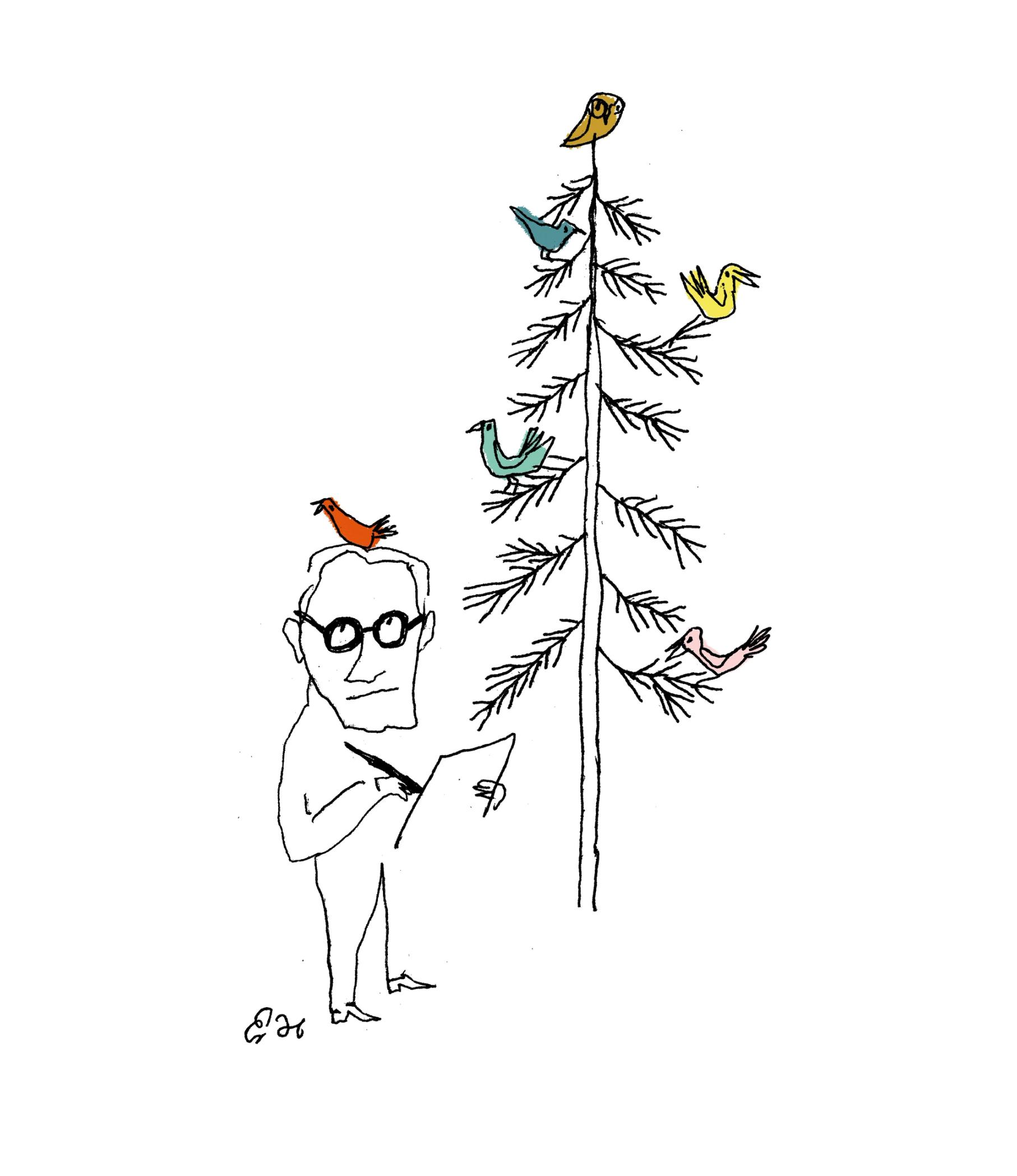When I was starting out as an illustrator, and didn’t have a well-known style of my own, my art rep would sometimes come to me with a project, explaining they wanted something “Blechman-ish.” That sounds cryptic, but I knew what she meant. The client wanted something that was loose and noodling and charming and minimal, something you might scribble on a cocktail napkin. But nothing is as difficult as charming minimalism. For economy of line and clarity of what the line is saying, R. O. Blechman is unmatched and inimitable.
The 1950s and ‘60s saw the invention of subtle, sophisticated advertising. Softer selling, wittier, low keyed, stylish, often self-deprecating, unelaborated, un-pushy. The unelaborated line invited the audience to fill in the blanks. By drawing quickly and minimally Blechman grabbed the eye and focused it on the story being told. “This will only take a moment.” People paused and got the message. Consumers were charmed. Ideas were delivered effortlessly. Blechman’s small, nebbishy figures with their shaky, discontinuous outlines seemed too frail to hoist a heavy message but told you everything you needed to know, and the messages stuck.
R. O. Blechman found his largest audiences with his animated television commercials. Again, no hard pitches, no booming voices, no big production numbers. The previous commercial would end loudly and the viewer would find him or herself beguiled by this shy, quiet doodle. There’s a famous commercial he did about an unhappy stomach. He’s upset because the man keeps eating spicy food. Solution: Alka Seltzer. The stomach is voiced by Gene Wilder. I wonder if viewers’ dyspepsia was calmed just by watching the commercial.
One of the season highlights of 1966 was a Christmas promo Mr. Blechman did for CBS. It featured a mostly empty screen with birds piping their songs on the branches of a fir tree. After a few notes the birds in the tree are joined by a woodsman carrying a saw, supposedly to cut down the tree. But he doesn’t cut the tree and take it home with him. He flexes his saw, sets a bow to it and begins playing along with the birds. Charming.
Blechman’s apparent effortlessness won awards and applause while also garnering attention and revenues for his clients. He also taught a generation of artists to speak quietly and quit beating people over the head.
R. O. Blechman was born Oscar Robert Blechman in 1930, in Brooklyn before it was hip. He attended the High School of Music and Art and then Oberlin College, where he drew political cartoons for the newspaper. But he didn’t major in Art. He majored in Literature and History (as I did.) While he was at Oberlin the final thesis for a college seminar in humor was titled Titus Fortunatus, or Why Rome Fell, for which he got the lowest grade in the class, a crummy B-. Classmate William Goldman (who later wrote the screenplay for Butch Cassidy and the Sundance Kid, for which he won an Oscar) also got a crummy B-. They were the only two who subsequently became famous creative artists.
In 1953 he drew some illustrations to Anatole France’s Christmas tale, The Juggler of Our Lady. The book was published that year by Henry Holt. A few years later Terrytoons (the makers of Mighty Mouse and Heckle and Jeckle cartoons) took the drawings Blechman had drawn in one evening and turned them into a nine minute animated film narrated by Boris Karloff. At this time he was also doing spot illustrations for Esquire and Harper’s Bazaar and Show and the English magazine Punch, as well as advertising illustrations for a New York bank, and for a line of ballet shoes. He’d never dreamed of becoming an artist. (I think his hesitant line quality demonstrates that.) He was more interested in film. He jumped fully into that field in the early ‘70s when he founded the animation studio The Ink Tank. Ink Tank produced the Alka Seltzer commercials featuring the upset stomach complaining about the food he’s getting. People laughed, and then went out and bought Alka Seltzer.
Blechman’s closest thing to a full scale masterpiece came in the hour long animated film of Stravinsky’s “A Soldier’s Tale”, done for PBS in 1984. It was voiced by Andre Gregory, Max Von Sydow and others, and won an Emmy. Grand ideas flourish in a simple context. Drawings in a nervous ink line seem trivial but they invite us to wrap our thoughts around big things. Nimble simplicity doesn’t bog down or wear us out. Which may explain why he’s still at it.
I was never able to achieve the desired Blechmanism that early clients kept pestering me for, but my line has grown more economical and extemporaneous following his example. And, like him, I am still busy. A few years ago when I was teaching a class in professional practice at the Minneapolis College of Art and Design one of my students told me she’d done a recent internship in the design department at a national retailer. The art director there had brought her a folder of an artist’s work. Mine. He wanted her to do something “Hanson-ish.” I am a lot more “imitable” than Mr. Blechman.
Eric Hanson’s writing has been published by the Atlantic, McSweeney’s, Airmail, The Spectator, Smithsonian, the Washington Post, National Geographic, the Paris Review, The Mockingbird, The Week, Süddeutsche Zeitung Magazine, Skiing Magazine, The Lifted Brow (Australia), and The NYTyrant. A Book of Ages, about key moments in the lives of famous and infamous people, was published by Random House in 2008. (The sequel is seeking a publisher.)
His art has appeared in the New Yorker, the Atlantic, Vanity Fair, Spy, The New Republic, Harper’s, the Wall Street Journal, The Nation, The Spectator, Airmail, McSweeney’s, The Lamp, The Believer, Rolling Stone, Poetry, Outside, American Scholar, Hedgehog Review, VQR, Travel+Leisure, Gourmet, Oprah, Time, The New York Times, Die Zeit, Vi Foraeldre, the Washington Post, the LA Times, the Boston Globe, and other publications.
